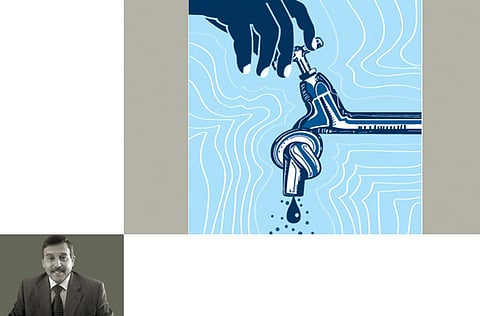Gross violations: Israel’s water theft
Failure to control water sources makes a Palestinian state impossible to achieve

According to many international organisations, water is being used by Israel as a war weapon, threatening the life of the Palestinian people. Since the creation of the Zionist entity in Palestine, Israel has been working relentlessly on annexing Palestinian land and water sources lying beneath. Such a strategic design was confirmed in a document prepared, in 1941, by David Ben-Gurion (Israel’s first prime minister). In this document (which was released by the British Public Record Office) Ben-Gurion stated: “We have to remember that for the Jewish state’s ability to survive, it must have within its borders, the waters of [rivers] Jordan and Litani.”
To make things worse, Israel’s erection of the racist/apartheid Wall in the occupied Palestinian territories, as from 2002, further added to the adversities of Palestinians. Under the pretext of security, the Wall has actually enabled Israel to seize 37 Palestinian water wells, reach major aquifers in the West Bank and make 30 other wells very hard to reach and use by Palestinians. In this respect, a Palestinian research project confirmed that “the geographical line of the Wall exactly coincides 100 per cent with the line of the aquifers in the occupied West Bank”. A recent BirZeit University symposium also concluded that “the Wall will be extending 670km to surround the cities and villages of the West Bank, thus eventually annexing 40 per cent of the total land of the West Bank. The design of the Wall was made with the intention of imposing direct and full control over the water resources of the West Bank”. This may well explain why Israel has always insisted on postponing the issue of water resources to the final stage of negotiations with the Palestinians, while continuing its expansion of colonies as well as keeping control of Palestinian water resources. Israel has been deliberately planting its colonies in the Palestinian occupied territories above the Palestinian aquifers to deny them whatever little water is left. As for the Palestinian water that could not be stolen, the Israeli colonies undertook the task of polluting it with their industrial waste. Besides, the Israeli occupation is preventing the Palestinians from building and developing an efficient sewage system to protect their resources of drinking water in the occupied territories. This strategy is obviously part of a determined attempt to increase the agonies of Palestinians so that they find themselves forced to leave.
In 2011, the Census Bureau in Ramallah (Palestine) issued a report pertaining to Jewish colonies and water resources in the Palestinian land, which stated that “in spite of the rarity of water in comparison with human growth and expansion, the water crisis has taken an extreme and dangerous path after 1967. Water crisis has affected many Arab countries, especially after Israel gained control over water resources of the rivers – Jordan, Hasbani, Banias and Mount Hermon — in addition to all the Palestinian aquifers. This made 81 per cent of all Palestinian water resources under the full Israeli control over the period 1967-2011, which left the Palestinians with only 850 cubic metres of water per year to use”. This situation has even deteriorated further because solving the water crisis has become impossible due to the continuous, aggressive Israeli measures of stealing Palestinian water. Dr Shaddad Al Oteily, Chief of Water Resources in the Palestinian National Authority (PNA), recently stated that “International studies, along with Israeli official studies, show clearly that every Israeli colonist in the occupied Palestinian territories consumes water 70 times more than the Palestinian individual”. His remarks were confirmed by the Israeli human rights group B’tselem and an unprecedented French parliament report authored by socialist MP Jean Glavani — once a minister of agriculture — accusing Israel of implementing “apartheid” policies in its allocation of water resources in the West Bank. Al Oteily also revealed that “water available to the Palestinians in the West Bank amounts to 105 million cubic metres from springs and aquifers, which is much less than what was available in 1995 according to the Oslo Agreement, which designated 118 million cubic metres to them. According to international standards, the Palestinians should have 400 million cubic metres. Yet, they are getting only 25 per cent of their need, which is being augmented with 56 million cubic metres that the PNA buys from Israel, four million cubic metres of which are being allocated for Gaza”. Furthermore, according to a UN report, “there are currently 56 springs in the West Bank near Israeli colonies, 30 of them were annexed by the Israelis who are denying the Palestinians access to them, while the rest of the 26 springs are under strict Israeli supervision as a prelude to annexation”. The international report conceded that “the Palestinians were terrorised by acts of violence meant to prevent them from reaching the annexed springs which are being used as tourist attraction areas to support the infrastructure of the Israeli colonies, while decreasing the Palestinian presence in the areas”. The report concluded that “the annexation of the springs and the aquifers of the Palestinians is only a part of the colonial Israeli expansion in the West Bank”.
Under such conditions, it might be right to presume that the failure of Palestinians to control their water resources — among several other resources — makes the establishment of an independent Palestinian state almost impossible. The ultimate intent of the Israeli occupation is to make the lives of Palestinians unbearable. The lack of water to quench their thirst, as such, is meant to force them out of their homeland, in order to fulfil the Israeli project aiming to evict Palestinians from their historic land, in the context of the so-called Judaisation of Palestine.
Professor As’ad Abdul Rahman is the chairman of the Palestinian Encyclopaedia.
Sign up for the Daily Briefing
Get the latest news and updates straight to your inbox



